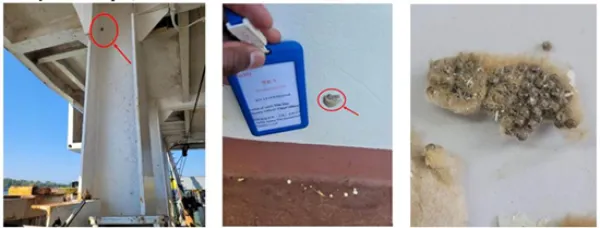NEW ORLEANS – In late September, U.S. Customs and Border Protection (CBP) agriculture specialists discovered four Asian gypsy moth (AGM) egg masses on a vessel from China.
CBP agriculture specialists boarded and inspected the Panamanian bulk carrier in Laplace, LA. CBP targeted the vessel for inspection due to it having ports of call at AGM high-risk areas in China during the current risk season. The vessel, carrying magnesite 97, was certified by a third-party surveyor as AGM-free in Tianjin, China, on August 12, 2022.
CBP agriculture specialists found four suspected AGM egg masses on the exterior surfaces of the vessel and railing on both lower and main decks. These egg masses are typically found near light sources and in areas protected from the elements. They treated the infested areas with Golden Pest Spray Oil (an EPA-registered pesticide), but due to the excessive amount of egg masses, U.S. officials ordered the vessel to immediately leave the port and anchor out of U.S. waters for cleaning and disinfection.
CBP sent the suspected AGM egg masses to the U.S. Department of Agriculture (USDA) entomologist who tentatively identified the specimen as AGM. USDA forwarded the specimens to their Animal and Plant Health Inspection Service, Forest Pest Methods Laboratory in Massachusetts for final analysis, and on October 11, 2022, they positively identified the specimens via molecular testing as Lymantria dispar asiatica, which confirmed it to be AGM.
According to USDA, AGM is an exotic pest not established in the United States. If they became established here, they could cause serious, widespread damage to our country’s landscape and natural resources. AGM are similar to European gypsy moths that are found in the northeastern United States, but the Asian variety have a much broader host range, making them more dangerous to U.S. agricultural and natural resources. Each female moth can lay hundreds of eggs that, in turn, yield hundreds of voracious caterpillars that could feed on more than 500 plant species.
Several days after the initial discovery, CBP conducted a follow up inspection. They found no additional AGM egg masses and granted the vessel permission to proceed with their cargo operations.
“Our CBP agriculture specialists have extensive training and experience in the biological sciences,” said Terri Edwards, Area Port Director of New Orleans. “They carefully inspect tens of thousands of international passengers, along with air and sea cargo being imported to the United States. Today’s European gypsy moth infestation came from a release of captive moths in Massachusetts 150 years ago, so yes, we’ll turn around a 740-foot bulk carrier over 4 tiny egg masses.”
During a typical day last year, CBP agriculture specialists across the nation intercepted 264 pests at U.S. ports of entry and 2,548 materials for quarantine: plant, meat, animal byproduct, and soil.
These seizures took place within the New Orleans Field Office, which covers ports of entry throughout the states of Louisiana, Mississippi, Alabama, Arkansas and Tennessee.
Follow CBP on Twitter @CBPGulfCoast and @DFONewOrleans


